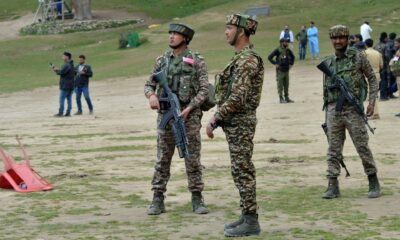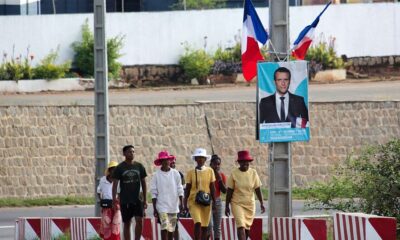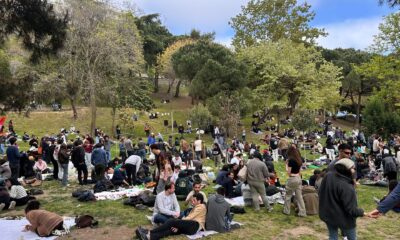Conflict Zones
‘We are condemned’: Kashmiri tourism pays the price of Pahalgam killings | Tourism News

Pahalgam, Indian-administered Kashmir – On Monday this week, Pahalgam in Indian-administered Kashmir was a bustling tourist destination. Today, it’s a ghost town.
Suspected rebels killed at least 26 people on Tuesday in the picturesque tourist resort in the deadliest such attack in 25 years in Indian-administered Kashmir, raising fears of an escalation in India-Pakistan tensions.
The Resistance Front (TRF), a little-known armed group that emerged in the region in 2019, claimed responsibility for the attack. In recent years, armed rebels who are demanding Kashmir’s secession from India, have largely spared tourists from their attacks. Tuesday’s killings have changed that.
Along the Liddar River, which winds through the picturesque valley, all the hotels have closed, and the shops stand shuttered. The town, which draws millions of visitors each year, has emptied almost overnight.
“I was so busy yesterday morning, I didn’t even have time to speak to anyone,” Mushtaq Ahmad, 45, a restaurant owner, tells Al Jazeera. By Wednesday, he had been forced to close his restaurant, and now believes the outlook is bleak.
“We are condemned forever. I don’t think the industry will recover now,” he says.
Another hotelier, Arshad Ahmad, says he had been overwhelmed by customers this year. Now, that has all changed.
“All my 20 rooms were booked for the next month,” he says. “But everything changed overnight. All my customers left early this morning. They were sad, frightened, and terrified – and rightly so.”
Among the dead at Baisaran meadow, Pahalgam, a beauty spot favoured by tourists, was local Kashmiri pony rider and guide Adil Hussain Shah, 29, who lost his life while trying to protect people.
Set amid panoramic mountains, women in colourful scarves and grey tweed pherans – long, traditional Kashmiri garments – stand outside the portico of Adil’s home in Pahalgam. Resting against the beams, they watch solemnly as representatives of India’s national television outlets and correspondents from major newspapers stream into this remote village.
“A woman whose father was killed told me that my brother confronted the terrorists and tried to reason with them not to kill innocents,” Adil’s brother, Naushad Shah, tells Al Jazeera at his home in Hapat Nar village in Pahalgam, where most of the people either work as pony riders or tourist guides, earning an income of up to $5 a day. “He tried to snatch their rifle and was trying to save the woman’s father, but he was shot in the head and shoulder,” his brother, Naushad Shah, told Al Jazeera.
Jammu and Kashmir’s Chief Minister Omar Abdullah attended his funeral on Wednesday and praised his bravery.
“Terrorism has no religion. We have always taken care of tourists and have been their support in the high mountains. This tragedy will hit us in the worst ways,” Naushad says, crying.

A mass exodus
Amid the rising tension following the attack, which has prompted a strong response from India – including suspension of a key water-sharing treaty and the closure of the mainland border crossing to Pakistan – thousands of tourists across Kashmir have packed their bags and were seen rushing to the airport.
“I had come to Kashmir on April 21 and was planning to stay till the 28th, but now I am terrified and leaving for my home in Haryana,” 45-year-old Himani Sharma, who was staying at a hotel on the banks of Dal Lake in Srinagar city, tells Al Jazeera near the lake as she boards a taxi towards the airport with her family.
“My two kids and husband are scared.”
The Indian government issued an advisory instructing airlines to assist tourists in the face of a surge in prices for airfares, citing “an unexpected demand from tourists seeking to return to their homes” and waiving cancellation and rescheduling fees.
In a post on X on Wednesday, Chief Minister Omar Abdullah wrote, “It’s heartbreaking to see the exodus of our guests from the Valley after Tuesday’s tragic terror attack in Pahalgam, but at the same time, we totally understand why people would want to leave.”
The situation is compounded by the shutdown of the national highway, the major road link between Kashmir and the rest of India, because of landslides on April 20 in the Ramban area, located 150km (93 miles) from the main city of Srinagar, that have destroyed part of the highway.
Abdullah said that while New Delhi is working to organise extra flights for people wishing to leave Kashmir, the highway between Srinagar and Jammu has been reconnected for traffic in a single direction.
“I have directed the administration to facilitate traffic between Srinagar & Jammu, allowing tourist vehicles to leave,” Abdullah wrote. “This will have to be done in a controlled and organised way because the road is still unstable in places, and we are also working hard to clear all the stranded vehicles. We will not be able to permit completely free movement of vehicles at the moment & we hope that everyone will cooperate with us.”
In Kashmir this week, people have come out in large numbers alongside regional politicians and trader guilds to protest against the killings.
In the southern district of Doda, mosques were blaring out their condemnations on loudspeakers on Wednesday. Many hotels and residents are offering free lodgings for stranded tourists and are waiving cancellation fees for those leaving the valley in distress.

But this untimely mass exit by tourists has come as a major blow to local people, many of whom rely on the tourism industry. Gulzar Ahmad Wani, 40, a taxi driver, earns up to $52 a day ferrying tourists from other parts of India to and from the three most popular resorts in Pahalgam.
“They are brought to us by travel agents. I generally make two back-and-forth rounds across three destinations in a day. One from 9am to 12noon, and the second from 1pm to 4pm,” he says.
Since the devastating attack, all his bookings have been cancelled, and the clients who had already arrived have now fled. Almost 90 percent of all tourist bookings in the region have now been cancelled, industry insiders say.
“What has happened is akin to pouring a vial of poison into the food that has just been prepared,” Wani says. “This was the peak tourist season, and we were expected to keep this momentum and earn a decent income this year.”
Wani shares a three-storey house with his siblings in Laripora, an idyllic village ringed by the majestic pine-covered forests in southern Kashmir. But the structure is 40 years old and crumbling.
He had applied for financial assistance under the Pradhan Mantri Awas Yojana, a federal government credit-linked subsidy scheme to facilitate access to affordable housing for low- and moderate-income residents.
“I had even been selected to receive the assistance. But unfortunately, it now seems that I cannot take it because I won’t be able to scrape together the rest of the money needed to build the house,” he says.

Peak tourism season
According to official figures, more than 23 million tourists visited the Indian-administered region of Jammu and Kashmir in 2024, and this year, the figures had been expected to rise even higher. But tourism has suffered here before.
In 2019, when Article 370, which previously granted autonomous status to Jammu and Kashmir state, was revoked, a major clampdown on Kashmiris by the Indian government took place, with police and paramilitary forces deployed in large numbers to prevent protests. People were jailed under strict pre-trial laws, the internet was suspended and government critics were subsequently arrested on “terrorism” charges. Tourism figures dropped off and continued to be flat throughout the COVID-19 pandemic.
In recent years, however, numbers were rising again – backed by promotional campaigns by the Indian government.
Pahalgam is one of Indian-administered Kashmir’s most popular tourist destinations, with breathtaking landscapes perfect for photography, trekking, pony rides, fishing, river rafting and nature walks. It is surrounded by vast alpine meadows and pine forests with multiple lakes.
The place is also politically significant for New Delhi as it serves as a base camp for the annual Amarnath Yatra, one of the holiest pilgrimages for Hindus in India. Every year, hundreds of thousands of pilgrims pass through the high meadows for more than a monthlong pilgrimage.
The area has also long been a favourite Bollywood filming location, and features in classics such as Betaab, after which one of the nearby valleys too is named.
With its efforts to restore tourism, however, the Indian government has come in for accusations of trying to suggest that Kashmir had returned to a state of normalcy. One parliamentarian even called tourism a “cultural invasion” and accused the government of politicising tourism in a region where critics can still be arrested using draconian laws under which a person can be held in detention for lengthy periods of time without a trial.
India’s decision to host a G20 tourism meeting in 2023 in Kashmir was also criticised by Fernand de Varennes, UN special rapporteur on minority issues, as “seeking to normalise what some have described as a military occupation by instrumentalising a G20 meeting and portraying an international ‘seal of approval’.”
Given its significance in the region, the area is heavily patrolled by the army, paramilitary troops, and local police.
There are multiple security checkpoints at entry points, and during the annual Hindu pilgrimage, which is set to begin on July 3, security is heightened through the use of drones, surveillance equipment, and road checks. Against that backdrop, Tuesday’s attack has shocked locals and visitors alike.
“In a scenario where normal life is heavily under surveillance, it is the government that has to be held accountable. This incident has hurt the locals most; we are in grief,” a local handicraft shopkeeper in the main city of Srinagar tells Al Jazeera, requesting anonymity.

‘Taking us back to the 1990s’
Mir Imaad was taking pictures of the vibrant tulip buds adorning his hotel in Pahalgam on Tuesday when he noticed helicopters whirring overhead. He says the unusual activity caused him to suspect that something must be amiss. “Then, someone brought a female visitor who had been lodging at our hotel back to her room. Her husband had been killed in the attack,” the 31-year-old hotelier tells Al Jazeera.
By the next day, thousands of fear-stricken tourists had packed up their belongings and begun racing to the airport in taxis through the highways flanked on both sides by sprawling mustard fields.
Meanwhile, mass cancellations by tourists have put about 500 hotel owners in Pahalgam in a fix. Imaad has paid out $2,400 in refunds, and others are doing the same.
“We hired skilled professionals over the last few years. Our chefs and the staff overseeing the catering are among the best in the region,” says Imaad. “This hotel was built in 1938 and had a huge reputation to which we had to live up. But now we are confronted with the staff that simply doesn’t want to be here. I don’t know what will happen now.”
Economic experts also believe the news of the attack on Tuesday will discourage direct investment into Kashmir. “The precursor for good economic activity is how much good news is coming out of the state,” says Ejaz Ayoub, a Srinagar-based economist. “When tourism increases, a sense of positivity towards investment increases. In the last three years, the investment ratio in the region’s GDP has increased – albeit marginally.”
But Ayoub also believes that the tourist exodus will not undermine the region’s economy in the way it is being projected in the mainstream Indian media.
“Tourism’s overall contribution to our GDP is marginal. The hotel industry [in this region] earns $324m annually, which accounts for only 1 percent of our GDP. When considering the trickle-down effect through the secondary and tertiary sectors, which includes tour operators or individuals associated with the gig-economy like the ponywallas, the figure can expand to $720m. But that’s still very little compared to agriculture’s contribution.”
Ayoub, however, said the damage to tourism will affect the collection of a form of indirect tax called Goods and Services Tax (GST). “Indirect taxation decreases due to lower trade volumes,” he added.

‘Anxious about the future’
Abdul Wahid Wani, 38, a pony-ride operator, was one of the first people to reach the bloody scene to look for survivors on Tuesday after a friend in the police alerted him to the tragedy.
He climbed the scree-laden path leading to Baisaran meadow, where the carnage took place. Since the route is rugged and uphill, only pony ride operators like Wani can carry people up to the beauty spot.
“I couldn’t have lifted all the injured survivors myself,” he explains. So, he shot a video of the scene and shared it on a WhatsApp group with hundreds of his fellow ponywallas, as they are called. “Some of them arrived quickly,” Wahid says. “That’s how we rescued them.”
The videos, which went viral all over India, now form the crucial evidence that police are relying on as part of their probe into the incident.
But while he is locally being hailed as a hero, Wani is plagued with anxiety about how he will earn a living from now on. On Thursday, the flights landing in Srinagar were nearly empty while the airport itself was packed with the panicked tourists looking to catch the first flight on their way out.
Some Indian nationals have even put their plans to visit the Valley on hold. “I was planning to come this year. But now, I won’t,” said Bhaskar Bhatt, who lives in New Delhi.
In the current season, which Wani described as the “best”, he was earning up to $11 a day, a decent income in this area.
“I could afford to get my children to study at a private school,” he said. Wani has two daughters aged 14 and 11, and a son who is seven years old.
“I don’t want my children to suffer from the lack of education that I have. I don’t want them to have a hardscrabble life as a pony operator.”
Conflict Zones
Yemen’s Houthi fighters down $200m worth of US drones in under six weeks | Houthis News

US loses drones in Yemen as rising civilian toll fuels backlash over Trump’s air campaign.
Yemen’s Houthi armed group has shot down seven US Reaper drones worth more than $200m in recent weeks, marking the most significant material loss yet in Washington’s campaign against the fighters.
The drones were destroyed between March 31 and April 22, according to defence officials, as the Houthis step up efforts to target United States aircraft operating over Yemen.
Three of the drones were lost in the past week alone, suggesting an improvement in the Houthis’ ability to strike high-altitude US aircraft.
The drones – each costing about $30m – were conducting surveillance or attack missions when they crashed into water or land. A defence official said the strikes occurred on March 31 and on April 3, 9, 13, 18, 19 and 22, according to The Associated Press news agency.
Dozens of civilians have been reported killed in Houthi-controlled parts of Yemen since March 15 after US President Donald Trump ordered daily strikes against the group.
Central Command spokesperson Dave Eastburn said on Thursday that US forces have struck more than 800 targets, destroying command centres, weapons depots and air defences, and killing hundreds of Houthi fighters and leaders. This claim could not be independently verified.
Another US official, speaking on condition of anonymity, said the drone losses are under investigation but are likely the result of hostile fire, the AP reported.
The Houthis have targeted mainly Israeli, US and British ships passing through the Bab al-Mandeb Strait in protest against Israel’s war on Gaza. The group has said the attacks would stop if Israel agreed to a permanent ceasefire.
Mounting civilian death toll
The Trump administration appears to have shifted from targeting only infrastructure to deliberately striking figures within the Houthi movement.
The strategic change comes amid rising civilian casualties from the US-led campaign, according to Airwars, a UK-based monitoring group.
Airwars estimates that between 27 and 55 civilians were killed in US strikes during March. The group believes the toll in April is already considerably higher, though full figures remain unconfirmed.
Earlier this month, a US air strike targeted the Ras Isa port, also in Hodeidah, killing at least 80 people and wounding more than 150.
This was followed by another attack on Monday, which killed 12 people and wounded more than 30 others in Yemen’s capital Sanaa.
Concerns are growing in Washington over the human cost of the campaign.
Senators Chris Van Hollen, Elizabeth Warren and Tim Kaine have written to Defence Secretary Pete Hegseth, questioning whether the administration is abandoning its responsibility to reduce civilian harm, particularly after reports emerged about the high civilian death toll on the Ras Isa fuel terminal.
Conflict Zones
Pakistan announces retaliatory measures against India after Kashmir attack | Conflict News

Pakistan has announced a series of retaliatory diplomatic moves against India and demanded evidence to back up the Indian government’s claims that Islamabad was involved in the Kashmir attack.
Suspected rebels killed at least 26 people on Tuesday in the picturesque tourist resort of Pahalgam in the deadliest such attack in a quarter-century in Indian-administered Kashmir. A statement issued in the name of The Resistance Front (TRF), which is believed to be an offshoot of the Pakistani-based Lashkar-e-Taiba armed group, claimed responsibility for the attack.
India’s Prime Minister Narendra Modi promised in a speech on Thursday to hunt the Pahalgam gunmen to the “ends of the earth”. New Delhi has also suspended India’s participation in a water-sharing agreement and sealed its main land border with Pakistan among other retaliatory measures.
On Thursday, Pakistani Prime Minister Shehbaz Sharif also paused a canal irrigation project, a day after India withdrew from the Indus Waters Treaty in a move that has caused concern about Pakistan’s water supplies.
In a statement released by his office, Sharif said that while Pakistan is concerned about the loss of the tourists’ lives [in Indian-administered Kashmir], “the Committee reviewed the Indian measures announced on 23 April 2025 and termed them unilateral, unjust, politically motivated, extremely irresponsible and devoid of legal merit.”
“In the absence of any credible investigation and verifiable evidence, attempts to link the Pahalgam attack with Pakistan are frivolous, devoid of rationality and defeat logic,” the statement added.
Pakistan’s Defence Minister Khawaja Asif later told Al Jazeera, “I refute, strongly refute, the allegations levelled by the Indian government,” and added that the country has “no connection” with armed groups operating in Indian-administered Kashmir.
Islamabad has also announced the impending closure of the Wagah border with India, but said it will remain open until April 30. All Indian citizens, excluding Sikh pilgrims, were ordered to leave in 48 hours.
Pakistan also suspended visas issued to Indians under the SAARC programme, reduced the Indian High Commission staff in Islamabad to 30 and closed its airspace to all Indian aircraft, while all trade activities with India were suspended.
Reporting from Haripur in Pakistan, Al Jazeera’s Kamal Hyder said it was a “tit-for-tat response”.
“All eyes will be on what India does next, because Modi has been saying that there will be a swift response. He’s meeting his party leaders in India, so that will be important,” he said.
“But Islamabad has not minced its words, either, by saying that any military response will be met reciprocally from the Pakistani side as well,” he added.
‘Please don’t think that Kashmiris are your enemies’
Pakistan and India both claim Kashmir in its entirety but administer parts of it separately.
On Thursday, Police in India-administered Kashmir released sketches and announced a reward for information about three suspects believed to be behind Tuesday’s deadly attack.
A reward of 2 million Indian rupees (about $23,000) has been offered for any information leading to their capture.
Police say the suspects are members of the group Lashkar-e-Taiba; they have been named as Hashim Musa (alias Sulaiman), Ali Bhai (alias Talha Bhai), and Adil Hussain Thoker.
According to police, Musa and Bhai are believed to be Pakistani nationals.
Thoker, also known as Adil Guree, is a resident of Kashmir, and investigators have linked him to the attack based on testimony from the wife of one of the victims.
A senior police official told Al Jazeera that more than 1,500 people have been detained for questioning in connection with the continuing investigation.
The region remains tense with heightened security and unease widespread across the region, two days after the Pahalgam attack.
But shops and businesses began reopening following a shutdown observed in protest yesterday.
Local trade bodies and political leaders had called for the shutdown as they took to the streets to condemn the deadly assault.
“Everything looks gloomy. We don’t know what the future holds for this place,” said Mehraj Ahmad Malik, who sells dried fruits in the main city of Srinagar.
“Everything was abuzz two days ago, and now there is fear and silence.”
Jammu and Kashmir Chief Minister Omar Abdullah has expressed deep sorrow over the recent attack in Pahalgam, acknowledging the loss of “25 guests who came here to enjoy their vacation” and praising a resident who “sacrificed his life to save the people there”.
“The people of Kashmir came out and voiced the same thing: that they were not involved and the attack was not for them,” he told India’s ANI news agency.
“Please don’t think that Kashmiris are your enemies; we are not guilty of it … We have also suffered for the last 35 years.”
Conflict Zones
Can South Africa help Russia and Ukraine reach a peace deal? | Russia-Ukraine war News

Pretoria, South Africa – As Ukrainian President Volodymyr Zelenskyy held talks with South African President Cyril Ramaphosa in Pretoria, the pro-Russia opposition condemned the visit while protesters gathered outside government buildings with a banner reading, “Shame on you, Ramaphosa and Zelenskyy.”
Zelenskyy cut short his first state visit to South Africa on Thursday, saying he would “return to Ukraine immediately” after overnight Russian attacks killed at least 12 people in Kyiv.
Since February 2022, Ukraine has been fending off a military onslaught by Moscow, aided by arms and support from allies in Europe and the United States.
Pretoria has remained neutral, calling for dialogue between both sides.
According to the Office of the United Nations High Commissioner for Human Rights, an estimated 12,910 civilians have been killed in Ukraine since the war started.
But South Africa’s main opposition political party, the uMkhonto weSizwe (MK) Party of former President Jacob Zuma, has taken aim squarely at Ukraine, blaming it for the current crisis.
“The MK Party strongly condemns Mr Ramaphosa’s misguided decision to extend an invitation to Volodymyr Zelenskyy, a figure widely discredited among progressive and nonaligned nations,” Floyd Shivambu, the secretary-general of the MK said earlier this month when the visit was announced.
Zelenskyy, Shivambu said, was the “puppet” president of NATO and the West and someone who “sought to destabilise Eastern Europe and the entire world”.
“We think [Zelenskyy] is the cause of the war between Russia and Ukraine. He provoked Putin,” Magazela Mzobe, a senior aide to Zuma, told Al Jazeera this week, urging protests.
“We regard Russia and President Putin as our friends.”
Zuma previously claimed that NATO countries instigated the “crisis” in Ukraine in a bid to counteract the BRICS alliance – a group of large developing world economies that includes Russia and South Africa.
South Africa, a historical ally of Russia mainly due to the support the former Soviet Union provided antiapartheid and decolonial movements in Africa, has not condemned Russia or Putin, has abstained from a United Nations resolution doing so and has maintained good ties with Moscow.

Put ‘strong pressure on Russia’
Days before meeting with Zelenskyy, Ramaphosa had a telephone call with Putin in which, he said, the two “committed to working together towards a peaceful resolution of the Russia-Ukraine conflict”.
Hours before meeting Zelenskyy on Thursday, Ramaphosa said he had also spoken with US President Donald Trump and the two agreed that the war in Ukraine needed to stop.
Ukraine faces ongoing pressure to accept stringent US conditions for a peace deal.
On Wednesday, Trump had chastised Zelenskyy for rejecting a Trump administration proposal that would see him cede Crimea to Russia.
After Thursday’s talks with Ramaphosa, in which the leaders discussed improving trade as well as ending the war, Zelenskyy said that while Ukraine is open to an unconditional ceasefire, pressure needed to be put on Moscow because it was up to Russia to halt attacks.
“We do not see signs of the US putting strong pressure on Russia as part of its peace push,” he told journalists in Pretoria. Zelenskyy said a new set of proposals was on Trump’s desk after talks on Wednesday in London.
When pushed about what he would be willing to compromise on during peace talks, Zelenskyy said he was ready to abide by what was proposed but could not go against the Ukrainian Constitution.
“It is already a big compromise on Ukraine’s part to agree to sit down with Russia once a ceasefire is in place,” he said.
If an unconditional ceasefire is enforced, the question remains who would be a guarantor of it. Zelenskyy said it should be a NATO country that is strong enough to withstand Russia. Ramaphosa said South Africa and other African countries stood ready to be a guarantor to ensure peace.
Against the backdrop of Zelenskyy’s visit, some questioned why South Africa would want to help broker peace – and what role it could play.

Does South Africa have influence?
South African Foreign Affairs Minister Ronald Lamola says his country is well placed to mediate between Russia and Ukraine because of its history successfully negotiating an end to apartheid, as well as its role in mediating conflicts across Africa.
“We don’t believe funding wars resolves conflict. We believe talks end wars. We can’t out-gun our way out of conflict,” his spokesperson Chrispin Phiri told Al Jazeera.
However, political analysts watching developments are not all convinced Pretoria has a role to play or whether its efforts could even help yield the desired peace outcomes.
“The Americans and Russians are discussing. And this discussion is very resistant to the allies of the Americans, the Europeans. They have not been involved. They have been fighting to get around the table,” said political analyst Kingsley Makhubela from the University of Pretoria.
“I don’t understand what value South Africa will have if the Europeans who have a direct interest in the resolution of the conflict have no influence around this.”
Makhubela said he was concerned about South Africa possibly being pulled between the interests of the US and the European Union in resolving the Ukraine war.
“We must not play into the hands of either party.”
Makhubela told Al Jazeera he did not believe Pretoria could persuade either the Russians or Ukrainians to commit to peace talks.
“I don’t know what South Africa’s strengths are to influence this process,” he said.
Regarding the opposition’s calls to protest Zelenskyy’s visit, Makhubela said they were not extraordinary.
“Internally, you will find groups from the far left and the far right will pronounce why they are against this visit,” he said.
The opposition MK Party, which protested Zelenskyy’s visit, also argued South Africa is ill-equipped to effectively negotiate peace between Ukraine and Russia.
However the MK itself – a breakaway faction from the African National Congress (ANC), the majority party in South Africa’s coalition government – has faced accusations of receiving Russian money.
Last year, John Steenhuisen – the leader of the Democratic Alliance (DA), the second-largest party in the governing coalition – accused the MK Party of being financially backed due to its links to Putin although he admitted there was no definitive proof. “I’m certain that money has flown into their accounts from Russia,” he remarked to the Financial Mail newspaper.
The MK denied the allegations of financial connections but has acknowledged the longstanding relationship between Zuma and Putin.
“President Zuma and President Putin have enjoyed a relationship that goes back 40 years. They’re friends. But that’s not the same as the Russian government supporting the MK Party,” party spokesperson Nhlamulo Ndlela said last year.
The MK Party’s affinity for Putin is no secret; it even markets regalia adorned with images of both Zuma and Putin. Zuma has also repeatedly sought medical treatment in Russia during and after his presidency. Additionally, he has faced allegations of corruptly securing a now-defunct nuclear deal with Russia during his time in office.
Nonetheless, the MK Party insisted its protest against Zelenskyy’s visit is unrelated to its leader’s close ties with Putin.

Ukraine ‘a democracy’ like South Africa
Despite the pushback to Zelenskyy from some quarters, the Ukrainian Association of South Africa (UAZA), represented by Dzvinka Kachur, was unfazed by the protests and opposition to his visit.
“South Africa, like Ukraine, is a democracy. In Russia, you cannot protest. If you go to the street, you will be arrested or you will disappear,” Kachur said.
The UAZA, representing about 1,000 Ukrainians residing in South Africa, advocates for improved communication between the two nations.
It has previously expressed criticism about the South African government’s failure to openly condemn Russia’s invasion of Ukraine, notably by abstaining from a UN vote.
The South African government has maintained its stance of nonalignment and is seeking to facilitate mediation in the conflict with Russia.
Speaking at a joint news conference with Zelenskyy on Thursday, Ramaphosa called upon both Russia and Ukraine to ensure there is a comprehensive ceasefire so negotiations can start.
He said South Africa believed the only path to peace is through diplomacy, inclusive dialogue and a commitment to the principles of the UN Charter.
He also expressed deep concern about the continuing conflict in Ukraine, the loss of civilian lives, damage to critical infrastructure and the deteriorating humanitarian situation.
Kachur told Al Jazeera that any attempt by Ramaphosa to broker peace between Russia and Ukraine would be contingent upon significant actions by Russia.
“A peaceful solution is only possible if Russia’s colonial system reforms,” she asserted, meaning Russia should stop taking Ukrainian territory. “If there is no change inside Russia, there can’t be peace.”
In Ramaphosa’s phone conversation with Putin before Zelenskyy’s visit, the Russian leader articulated his country’s position on the necessity of addressing the “root causes” of the conflict and ensuring Russia’s security interests, according to the Kremlin.
“South Africa will continue engaging all interested and affected parties, including the government of Ukraine, in finding a path to peace,” the South African Presidency said after the call.
But as pressure from the Trump administration mounts for an end to the war, the dichotomy between South African government neutrality, the main opposition’s staunch support for Russia and the host of international actors wanting a seat at the table leaves uncertainty as to the real role Pretoria could play.
-
Europe2 days ago
How to visit Rome for Pope Francis’ funeral and conclave
-

 Conflict Zones2 days ago
Conflict Zones2 days agoManhunt under way in Kashmir after deadly attack on tourists | Conflict News
-

 Education2 days ago
Education2 days agoHarvard’s president says the school will ‘not compromise’ on its rights with the Trump admin
-

 Lifestyle2 days ago
Lifestyle2 days agoNFL draft suits give prospects another way to cash in on their fame, flash their style on red carpet
-

 Africa2 days ago
Africa2 days agoEmmanuel Macron starts two-day visit to Madagascar
-

 Middle East2 days ago
Middle East2 days ago‘I grabbed my cat and ran’: Istanbul panics as earthquake hits | Earthquakes News
-
Europe2 days ago
New Prince Louis photo released to mark 7th birthday
-

 Europe1 day ago
Europe1 day ago‘The Art of the Deal’ meets global reality




